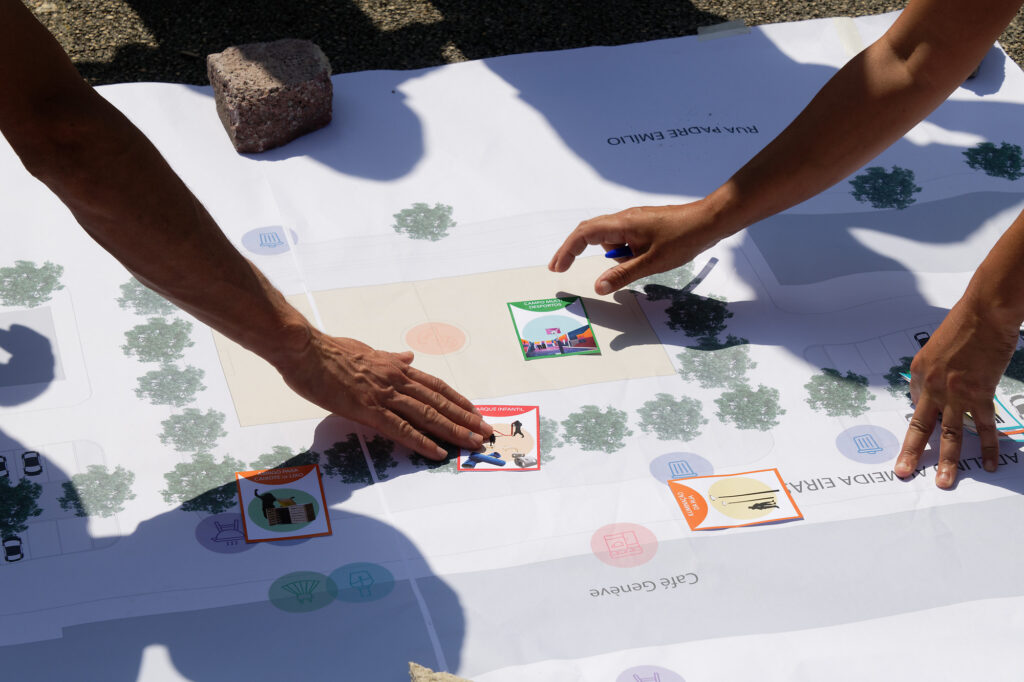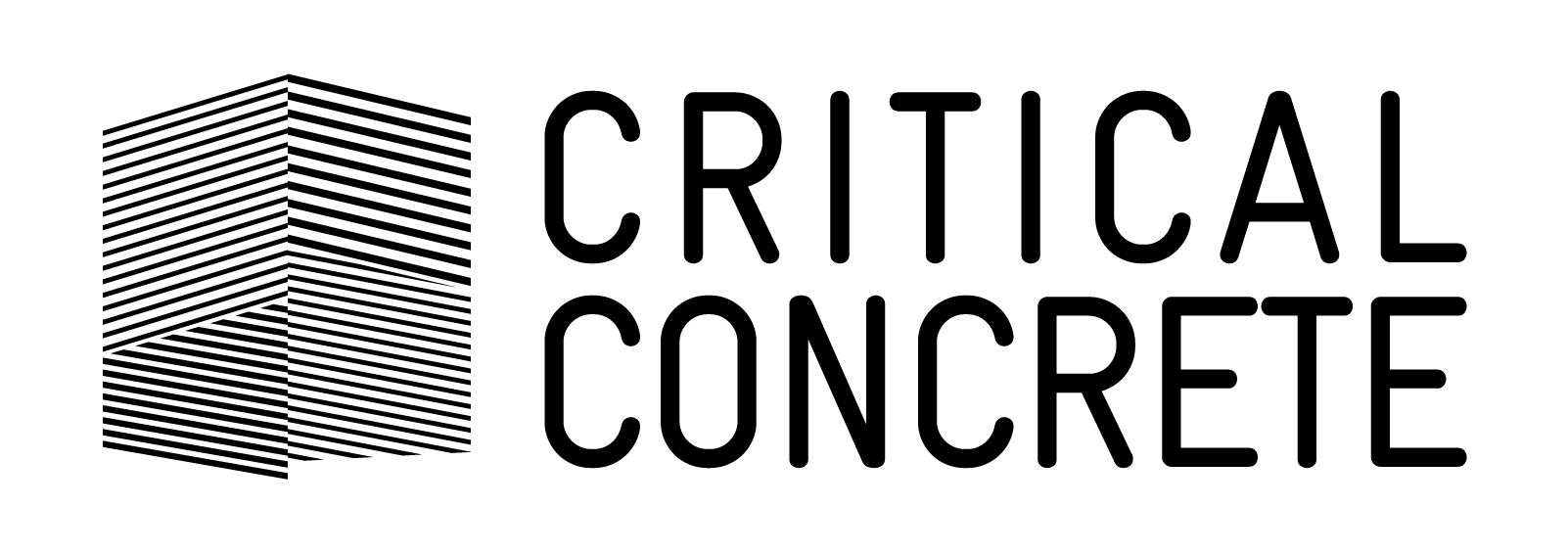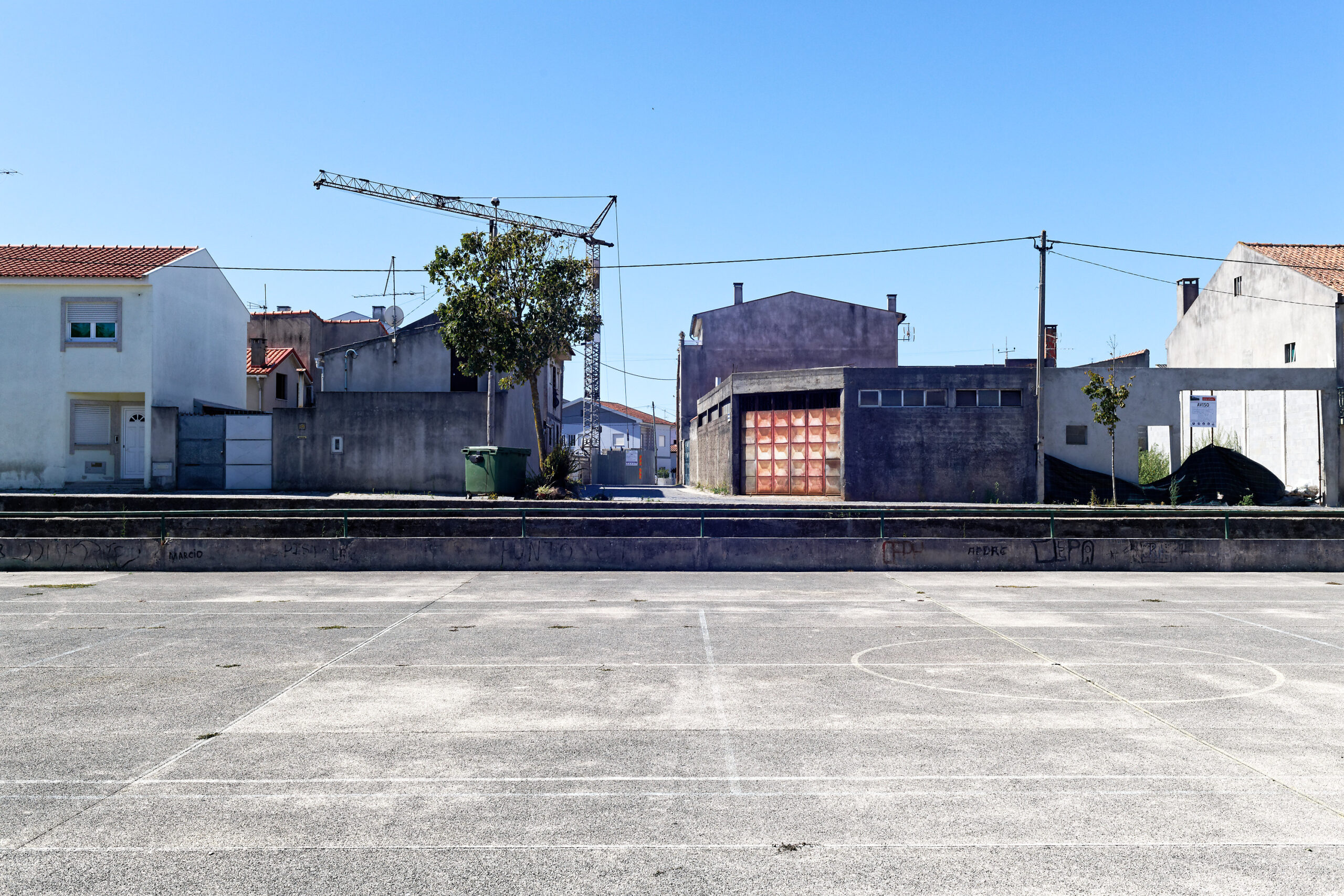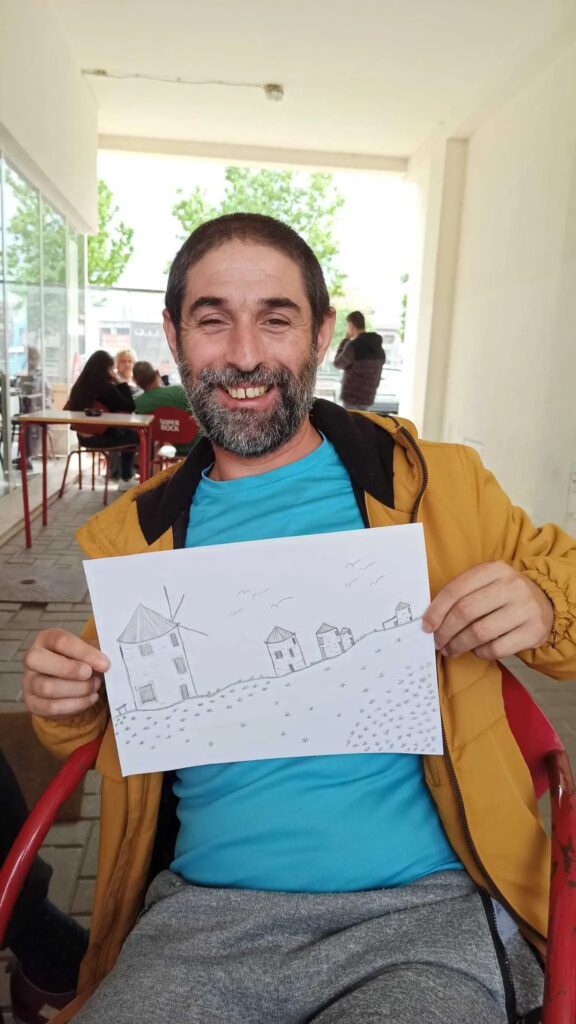Sustainable public space transformation: A case study in Apúlia
Public spaces should be dynamic spaces that fit the needs of surrounding communities and contribute to social cohesion.
These spaces are very important when we think of the liveability of our cities: and even more so when we are intervening in places where private living conditions are not providing all the comfort everyone should have access to.
They should integrate with nature and promote resilient ecosystems, facing nowadays’ harsh climate change. Temporary interventions can be used to foster the vibrancy of a community, however they often involve lots of materials that last for a season before being trashed. Additionally, they might not involve local residents in their design or transformation, focusing more on ‘occupying’ the space through bright structures or events with top-down processes.
To face those challenges we will need to change how public spaces are designed, programmed and managed. This renovation project has taken place for over a year endorsing a slow approach centred around community engagement and local partnership. Critical Concrete looks to challenge this reality by proposing long-lasting, sustainable spaces that are designed with rather than for local communities. In this article we will guide you through our process – from research to accomplishment – involving local actors, participatory design and regenerative planting.
We’d like to mention the support and help of all the many partners that made this project possible, from the Municipality of Esposende together with the Junta de Freguesias de Apúlia e Fão, supporting every initiative and embracing this experimental process, to Húmus Vivo, who led the soil regeneration process and planting, our workshop tutors Laurane Coornaert, Gianluca Stasi, Ana Baptista & Hugo Dourado, Joana de Rosa who involved the community through drawing and painting activities and multiple professionals who advised, contributed and actively participate to this project: Paulo Palha from Neoturf, Laura Sobral, CIN, Centro Escutista de Apúlia, Café Geneve and many more.
The little town of Apúlia, 50km north of Porto, is a coastal settlement home to 4,000 people. A popular tourist destination, Apúlia is traditionally known for its fishing and agricultural culture and its beautiful dune beaches. Our site is located at the heart of the village, in front of Ilha de Apúlia, a 90s Social Housing Block. The site consists of a rectangular space enclosed by an 100m long 3 storey block comprising 52 dwellings. The shorter sides of the rectangle houses two rows of 2 storey terraced houses, which, together with the long block, embrace an extended public area with a ringue (football field) at the centre.
The social housing block that characterizes the space; The football field is crowdy in Summer while kids are playing around
This enclosed space is not ordinarily used as a gathering space as it was 10 years ago. Instead, it mostly acted as a circulation vessel for cars, few bikes and pedestrians to move around the site. A few maple and cherry trees provided shading around the ringue – a small football field -, but the lack of benches and the inaccessibility caused by the damaged cement pavement blocks walkway did not encourage dwelling. In addition to this, the lack of accessible ramps and secure paths for people with reduced mobility is obstructing the circulation even more. The absence of shading also prevented people from getting together around the ringue: as the majority of the population is elderly, being exposed to the harsh sun is undesirable.
Still, young kids ran and played in the sundrenched ringue, although they soon lost their enthusiasm as there was nowhere amusing to climb, slide or hide.
Hence, the main focal point is the café, which keeps changing owners every few months as the lack of use of the space prevents an economically sustained activity. Located in a passage to access the garages in the backyard, it breaks the long block at its core, providing an outdoor and ventilated gathering point for its customers. Residents meet here at all times of the day, in the morning after a long fishing shift, for a quick coffee after lunch or for an evening beer. Next door stands the beauty salon and shop, which is the only other service provided on site.
The unemployment or retired rate among the residents reaches almost 40% of the population. The working inhabitants are mainly involved in fishing and farming or in the construction and textile industries settled around the area. The disadvantage Apúlians face is not merely financial, but also social: a high percentage of the people have only a primary school education, and many tenants are single parents or retired elders.
Café Geneve; The pic-nic area before intervention
While a vast number of Apúlians have now emigrated abroad for employment purposes (mostly to France, Luxembourg and Switzerland), they have kept their homes as summer houses. Most of the emigrants include younger working generations, so in summer the site has a higher population of children and families. This factor creates a contrast between an atmosphere of stillness during the colder seasons and a liveliness during summer, on the expats’ return. This led us to consider not only designing for the middle age/elderly (majority of the winter population), but also for children.
The Apúlia Public Space is part of the Portugal Inovação Social programme in partnership with the Municipality of Esposende and Ramalde. The purpose of the programme is to rehabilitate and enhance three private houses for vulnerable families, one community space and two public spaces in the Freguesias of Apúlia and Fão (Esposende Municipality), and Ramalde (Porto) across a period of three years (2020-2023). Presented with this public enhancement case, we chose to apply a participatory design process to involve the community in shaping their own space and we interviewed residents for research purposes. When endorsing participatory processes, the biggest challenge is always to connect with the community, building a connection to understand each other. Many communities, like Apúlia’s, are used to undergoing changes in which they don’t partake in the decision-making process so they lose trust in authorities and even designers.
Conscious of this, we decided to take a slower and considerate approach. Our strategy was divided in three phases: an initial investigation through punctual questionnaires, followed by a participatory and co-design plan and a participatory construction stage.

Participatory design and gamification session with Apúlia inhabitants
The first phase took place over the first year. By paying several visits to the site during Summer 2021, we informally spoke to the community, trying to understand how people live and use the space and settling the first proximity. We decided to start the research during August because we wanted to reach also the “temporary” users of the space. We also spoke with local partner authorities that previously investigated about the community and we reached out to Otílio Fradique dos Santos Hipólito, previous mayor of Apúlia to understand the historical and political context of the Ilha. Then, along the month of August we interviewed 45 inhabitants seeking specific data concerning their experiences and wishes/expectation of the space.
With the aim of encouraging the residents to genuinely reflect on their own ideas, in the second phase of the participatory design we prepared a gaming session gathering the inhabitants to openly discuss amongst each other. The game allowed the residents to identify the priorities they claimed most and come up with possible common solutions. By working together, we were able to observe the community’s social dynamics and collect their proposals. The gaming strategy is also breaking the bridge in between generations and moving the conversation into a more informal structure, bringing participants to not feel shy about personal propositions or concerns.
From the interviews, it emerged that most Apúlians sought places to share food, to sit for a chat, more playfulness and accessible circulation.
Taking these requests into account, we established a brief to realise through four stages:
1. Build urban furniture
2. Accessibility improvement
3. Create a greener landscape
4. Drawing and painting intervention
These four interventions are intended as an improvement of the existing conditions. They do not add new or propose other functions, instead they foster the current activities and uses. We were eager to avoid major changes, respecting the existing uses, traditions and culture.
1. The urban furniture
The urban furniture consists of three timber structures, designed and built in collaboration with a group of participants together with our team and with participants from the local community . The three structures act as multifunctional elements which allow activities to occur more easily, enhancing opportunities. In essence, the idea is to provide play, seating, gathering and dwelling areas that sit pleasantly under the tree’s shade and it’s incorporated with the trees. Two of the structures (structures 1 and 2) respond to this in their varying and unexpected form, defined by diagonal elements in section and in plan. In structure 1, the diagonal allows for play (climbing or sliding) but also for comfortable resting. Moreover, the diagonal function in plan (structure 2) allows for circulation to flow more fluidly and enables the structure to fold around the tree.
As expressed by the community, gathering people around a churrasco (traditional barbeque) on Sundays or on Patron Festivities is vital in the neighbourhood. The structure 3 gives support to this, providing a spacious picnic table at the centre of the shared garden, which was planted in our landscaping intervention (Area 3).
Due to our studio’s expertise in sustainable self-build, an environmentally sound solution was fundamental. For this purpose, we used natural and reclaimed materials both for the structure and for its treatment. To further explain, the timber structures are built upon reclaimed tyre foundations, safeguarding the wood’s decay through capillarity. The timber components are subsequently coated with Tricoil, a natural solution of linseed oil, turpentine and Tung oil. This coat protects the material from water and humidity, sun and a wide spectrum of insects, guaranteeing its durability. To further reduce our carbon footprint, the designs aim to limit the use of metal bolts as much as possible. Also, the strength and thickness of the sections will ensure long-lasting and low-maintenance furniture, limiting the need for future interventions and repairs.
Structure 1
This structure provides a resting, shady and playing space. Thanks to the inclined planes kids can climb or lay down in a comfortable position. Structure 1 is built just in front of the café trying to be in connection with its terrace and offering a comfortable sit under the sun.
Structure 2
The structures elevated around the big Acer and the green flowerbed. The hammock and the table/tunnels provides playfulness.
Structure 3
The table is thought to equip the pic-nic area together with the green intervention: a community orchard and edibles flowerbeds spots. The size of the table and the two benches allows more than 8 people sitting and aimed to offer a gathering spots in the pic-nic area for inhabitants that wish of spending a Sunday lunch together.
2. Accessibility improvement
As we previously stated, one of the core uses of the space is circulation. Cars go around the ringue to park and access dwellings, people cycle and walk and access the garages behind the housing and the services. Hence, it is crucial to preserve the pedestrian areas, preventing people from having to walk on the riskier road or needing to take a longer path. Seeing that the roots of the trees strongly emerged from the soil, they caused a lot of damage, unfastening the cement pavement blocks . As a result, the pedestrian path is bumpy and uneven, pushing people to walk around it or not use it at all. Taking this into account -and transforming it into an opportunity-, we removed the cement blocks in the damaged areas around the trees and we placed our structure in the places where the pavement were removed: allowing the trees’ roots to reach the surface and creating an opportunity for more life to prevail there. This way, the roots ceased to surface as much and the path was flattened.
The more problematic roots were also pruned to increase the consistency of the pavement.
The removed cement blocks were then employed as material to create benches, steps or seatings, enriching the space and its use. The new planting beds around the trees have been transformed into biodiverse green areas and protected by short cement block walls.
3. Create a greener landscape
With the help of Maria Catana from Húmus Vivo, our design also included the regeneration of the existing green areas. Maria’s approach is particularly attentive to the importance of breaking the stereotype of the tidy and clean garden, with a centred tree amongst a neat, freshly-cut grass patch. In an effort to push the urban realm closer to the natural realm, encouraging a stronger connection to wildlife, low-maintenance edible plants and perennial species that don’t require a big amount of water but take advantage of the air humidity, have been planted around the trees and in the picnic area (Zone 3). Such elements will allow for the setting of nests, reproducing a small-scale forest in a circular plan and providing a rich and healthy soil
A various mix of aromatic plants (rosemary, cilantro, thyme), edibles (lettuce, strawberry, cale, pepper, beetroots, pumpkin) are surmounted by a bush (laurel and pomegranate) and a tall fruit tree (apple and fig tree). In accordance with the natural habitat of Apùlia, succulents were integrated in the planting.
A similar approach was taken for the planting of the new flowerbeds created among the Maple trees in front of the football field, improving the quality of life of the community and the local biodiversity through resilient gardens. Being the superficial roots, vital parts of the root system of a tree, the stress induced by waterproofing and lack of space near the trunk, caused the roots to spread outwards seeking water and nutrients to subsist, but lifting the pavement in the process. The solution found for the degradation of the floor is composed of two action fronts. First, we opened the area around the trees, so that their needs are met through the superficial roots in exposed soil. Second, we proceed to roots and branches. By increasing the flowerbeds considerably, the tree is expected to recreate its surface root network in open spaces and no longer interfere with the pavement. These new beds have been filled with biodiverse vegetation, resilient and adapted to edaphoclimatic conditions, with the help of inhabitants. The mix of vegetation supports existing trees, contributes to the infiltration capacity of rainwater into the soil (dense draining root system), provides various medicinal and aromatic species (lavender, sea wormwood, mediterranean saltbush, sea fennel and others) for community use, contributes to the promotion of biodiversity in the urban context, and positively impacts the reduction of stress and quality of life, among others.
These planting workshops shared the concept of resilience and resistance in sustainable gardens according to growing climate challenges: low maintenance, low water needs and respecting community interests. In order to increase the biodiversity of the site, the community was told to bring plants they would like to see in their public space. Such a request fosters a sense of responsibility and appreciation for ongoing implementation and future care.
Moreover, the emphasis on gardening was encouraged by few residents, like Emidio, who already informally implemented vegetable patches taking care about the space and transforming a dry land into the beginning of a communitary vegetable garden. For this reason, creating a space for a community garden was essential. Here, we planted herbs for cooking, vegetables and fruit, for the community to care for and consume. Emidio, who has been busy gardening and cleaning the space over the past years, helped us improve this space, lending tools and his labour. After speaking to him and to other inhabitants, we realised this would be an ideal picnic area, due to its green environment and its quiet location. Together with Emidio, we got rid of the remaining garbage occupying the space, planted and built a spacious table with benches for sharing meals (Structure 3).
4. Participatory drawing and painting session
Another important step for the improvement of the area is the refurbishment of the existing football field, which is currently in a state of abandonment. Originally, the ringue played a vital role in the neighbourhood: it used to be a busy space, gathering people from all over the town to come and play or simply meet. Today, due to its damaged net boundary and its abrasive ground, it is not used as such anymore. Sometimes kids run here, but it rarely hosts a proper football game or a sports tournament.
With a requalification, the goal is to revive the space, bringing back people to enjoy and play here. Thanks to the 3×3 Basketball programme led by the Portuguese Basketball Federation, who have provided the funds and necessary equipment in tight collaboration with the municipality of Esposende.
The floor court will be coloured and decorated through a participatory drawing program led by illustrator Joana de Rosa. During her sessions, which took place over two months, Joana asked the residents to draw what is most representative to them about Apúlia’s culture and heritage. The drawings were then woven together in a collage by the illustrator into one final design, revitalising the field. Joana’s work will be integrated within the court, following the game lines and boundaries. Together with volunteers of the community, this project will be executed in late 2022.
Most of this project was complete and implemented during three weeks workshop by our team with the precious help of twenty two participants and four mentors coming from abroad to learn about self-build, sustainability strategies and techniques as well as participatory and co-design practices.
The students’ involvement was extremely enriching: coming from different backgrounds, they brought a stimulating contribution to the design and construction phases. The months prior to the workshop, we held several meetings to discuss design ideas together with them and with the community.
In the first two days of the atelier, the students co-designed and finalised together solutions that we translated into executive drawings to build during the following weeks. Modularity and durability were the key words for our design language. Our design concept evolved from having multifunctional structures trying to instead having a single module with specific functions that could be assembled together and composed in a free space. Translating necessities into shapes, we proposed a modular design language, whereby every module had a set structure with defined components that students could assemble and shape into a common solution. This allowed us to have a more efficient workflow, order the material on time and study the sections and joints for a precise construction.
Having three different projects in parallel allowed the students to rotate and work on different things, grasping knowledge on woodwork, gardening and building techniques. Seeing such a lively and engaged presence, members of the community were curious, asking questions when passing by, storytelling or suggesting ideas. Some like Américo, Fernando and Filipe got involved in the actual work, bringing their own tools and working on the structures and in the soil regeneration process, accompanying us with perseverance along the three weeks and bringing a valuable contribution to the work. They would join us in the morning and evening meetings and share lunch with us and coffee during breaks.






















Co-building workshop memories
The project was for us a beautiful and scary challenge: as our first urban scale project, involving a large number of stakeholders, partners and a diverse community. Although engaging the whole community can be challenging, the result was satisfying and will be long-lasting. In the past weeks, going back to the site we saw the structures being used and enjoyed by local people who hadn’t previously engaged in the project. Even specific aspects we had designed, uncertain of their use, were functioning such as the space under a table that was used by a couple of little girls as a tunnel. At lunchtime, a grandma was having sandwiches and juice with her nephews on the picnic table. In the evening, adults sit on the table or in the reclining structures, they share a beer and some snacks they buy at the bar across the street. In the meantime, the children play around, up and down the structures. After, they rest on the top seat, tired of all their running around.











































